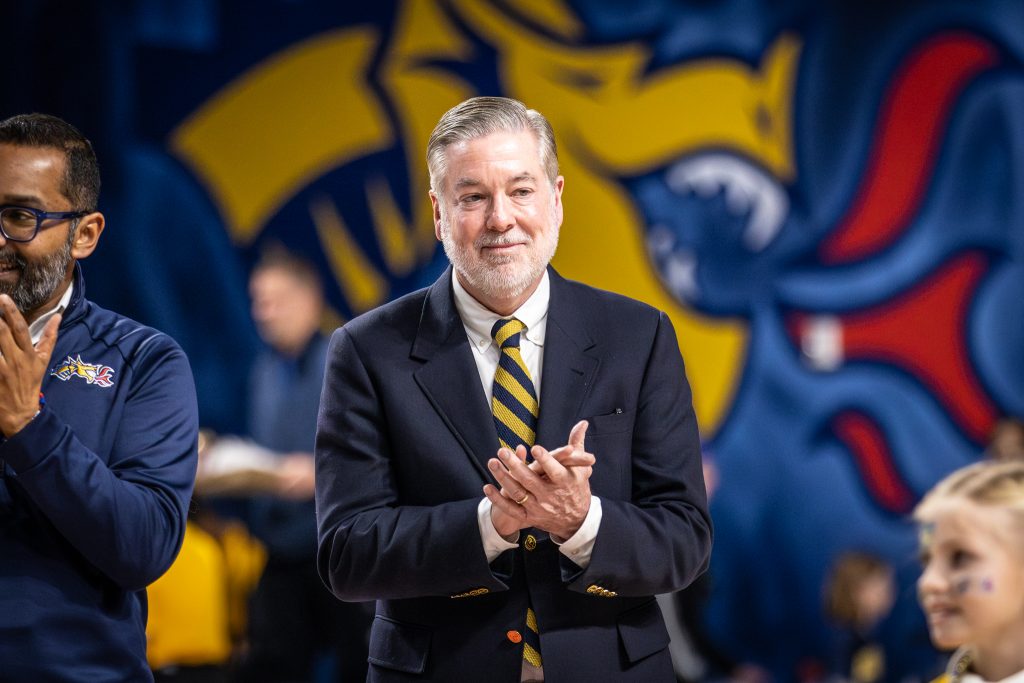
With the announcement of President John Fry’s departure from Drexel University, The Triangle looks back at Fry’s 14 year tenure.
2010 – In 2010, Fry was appointed Drexel’s 14th president. In his inaugural address, he made clear three major objectives for his presidency: to “become one of academe’s most powerful engines for neighborhood improvement and regional economic growth,” to “mobilize our entrepreneurial and creative energies to confront major threats to human health, economic prosperity and the environment” and to “[maximize] Drexel’s global reputation and impact.”
Fry had big shoes to fill: he succeeded Constantine “Taki” Papadakis, Drexel’s most transformative president up to that point. Papadakis had brought back the university after a long period of financial struggle. Under him, enrollment doubled, campus projects were undertaken and completed and the endowment grew.
Fry, with a background in private consulting by way of Lafayette College and New York University and no doctorate, did not seem like an obvious choice. However, thanks to his expertise in partnerships and urban redevelopment and prior experience at the University of Pennsylvania, he was unanimously elected president.
2011 – In 2011, under Fry’s jurisdiction, the former Academy of Natural Sciences of Philadelphia became The Academy of Natural Sciences of Drexel University. With Drexel’s funding, faculty and resources, the museum was able to further implement extensive programming and exhibitions for the public. Meanwhile, Drexel gained access to the Academy’s extensive collections, researchers and academic materials, bolstering the resources for Drexel’s students and its research credibility.
The same year, the U.S. Open Squash Championship came to campus. Fry, himself an avid squash player, was the partnership’s frontman.
2012 – In 2012, Fry announced a plan dubbed “Transforming the Modern Urban University,” to be implemented over the following five years. Its essential goal was to expand and strengthen Drexel’s reach: the growth of national and global co-op options, international relationships and reputation, connections with the wider Philadelphia community and improvement of online learning were all suggested.
Also in 2012, and in tandem with themes of global reach, Fry led two separate international delegations: one to Turkey and another to Israel. “[The trip] provided an opportunity to forge international collaborations in hopes of continuing our work to develop technologies that improve health and quality of life around the world,” Fry stated. Such trips are strategic; they fuel opportunities for research, study abroad, marketing and more. “Geography is no longer a barrier to partnership,” Fry said in 2012 after his trip to Israel.
2013 – Fry was elected Chairman of the U.S. Squash Board of Directors in 2013, serving for three years.
Drexel launched the Charles D. Close School of Entrepreneurship in 2013 to integrate entrepreneurial learning into the curriculum and support campus innovators.
2014 – Drexel opened the Dana and David Dornsife Center for Neighborhood Partnerships. The Dornsife Center offers space for community outreach activities developed and delivered by the University, as well as classes for Drexel students and neighborhood residents alike.
The same year, Drexel received a 50 million dollar donation from attorney Thomas R. Kline in exchange for naming rights to the School of Law. The gift also established the Thomas R. Kline Institute of Trial Advocacy and included a Center City landmark to be renovated for use as a courtroom simulator. The donation was orchestrated by Fry, whom Kline called “disarmingly persuasive.”
2015 – “In 2015 we moved aggressively to better focus our resources on academic excellence and student success,” Fry wrote in the introduction to his president’s report. This was the year Fry announced the intention to shift recruitment strategies with the goal of finding “right-fit” students. The focus lifted from mass-mailing applicants and instead appealing to more targeted, individualized students. This plan caused the University’s acceptance rate to decrease.
Also included in 2015’s plan was further development, expanding into new spaces and nearby neighborhoods, stretching as far as 30th Street. “We’re also going to do public realm planning, which I’m pretty excited about,” Fry said. “That’s to support and improve the aesthetics of the community spaces throughout the Drexel campus.”
This soon manifested in two significant projects. The first was the planned renovation of the Korman Center and Korman Quad after Drexel pledged to match an $8 million dollar donation towards the project. The second was the 212-room Study hotel at 20 S. 33rd Street developed on Drexel land leased by Hospitality 3. This unique development arrangement would serve as a blueprint for later projects on campus.
2016 – Fry began his service as Chairman for the Greater Philadelphia Chamber of Commerce. “As Chairman of the Chamber,” Fry said, “[I will] affect positive change for our members, area residents and the region’s economy.”
In 2016, Drexel partnered with the Brandywine Realty Trust on long term development projects, namely Philadelphia’s Schuylkill Yards, a “14-acre master planned community” between Drexel’s campus and 30th Street Station. This 20-year plan is still underway and has led to a building boom on and around campus, particularly in spaces for the life sciences.
Fry also gave his first convocation abroad at Nirma University in Ahmedabad, India. His trip to India featured tours to other universities, meetings with college administrators and an alumni event, all aimed to strengthen Drexel’s connection to India and cultivate opportunities for collaboration.
2019 – In June 2019, Drexel and its partners celebrated the opening of Drexel Square, the first completed project of Schuylkill Yards. The 1.3-acre park, with its distinctive dawn redwoods, sits outside the former Evening Bulletin building and is open to the public. Now One Drexel Plaza, the Bulletin building would become the home of Spark Therapeutics in 2021. “It says a lot about our collective vision for Schuylkill Yards that we chose to begin this $3.5 billion long term development with a public space open to everyone,” Fry remarked.
2020 – On March 13, 2020, as COVID-19 began to affect the region, Fry approved the decision to offer all winter term finals online. By March 20, dorms had closed to students, and it was clear that spring term would have to move online. Staff, students and administrators were forced to quickly adapt over the coming months, and the financial picture was dire: $90 million in budget cuts were needed. “It’s what you most fear,” he said. However, by the end of the year, the situation had largely stabilized. With a rapid transition to online instruction, adequate fall enrollment, fundraising and federal stimulus, Drexel was able to continue operating, with some financial restraint.
2021 – A signature piece of John Fry’s legacy is the Specter U.S. Squash Center, which held its grand opening at the former site of the Pennsylvania Armory on the university’s campus in fall 2021. As a music venue, the Armory featured acts including Nirvana and was for a time slated for the university’s next basketball arena. When that project fell through, a squash center was proposed in 2018. The facility was named for donor Arlen Specter, a Philadelphia attorney and former U.S. Senator. Team USA Squash will train in the U.S. Squash Center for the 2028 Los Angeles Olympics, the sport’s first appearance.
Furthermore, a huge step towards realizing the vision of the Schuylkill Yards plan was taken in 2021: groundbreaking at 3025 JFK Boulevard for the West Tower. The mixed-use, 570,000-square-foot building is the largest to be executed as part of the plan so far.
2022 – 2022 was another major year for campus construction; multiple projects were announced or saw ground broken. Buckley Field was closed to make way for 3201 Cuthbert, a new 500,000-square-foot life sciences center, with development led by Gattuso Development Partners. Gattuso holds a ground lease on the site, and Drexel will lease two floors for university uses.
2024 – What has turned out to be Fry’s final year at Drexel might also have the most bearing on his legacy. Two undertakings set to continue after his departure are Drexel’s merger with Salus University of Elkins Park, PA and the transition to a semester schedule. Since the Middle States Commission on Higher Education issued its approval, the Drexel and Salus administrations have begun the formal integration process. Many of Drexel and Salus’s clinical operations will be brought together under the umbrella of Drexel Health with the aim of furthering collaboration and improving patient outcomes.
Fry’s final year was further defined by controversy, both personal and political. The president’s salary in 2022 was reported as over $2.5 million dollars, making him the tenth highest paid private university president in the country. Against the backdrop of the war in Gaza, the university’s response to a pro-Palestinian encampment erected at Korman Quad proved highly divisive. The camp disbanded voluntarily under the threat of police removal. Moreover, Drexel has faced scrutiny from the Department of Education’s Office of Civil Rights over allegations of a lackluster response to antisemitism. A recent resolution saw the university acknowledge shortcomings in its anti-discrimination procedures, though the OCR did not substantiate the allegations.
Looking Forward – Carrying this legacy, effective November 1, 2024, John Fry will begin in his new role as president at Temple University. Drexel trustee Denis O’Brien will serve as interim president while the university seeks a permanent replacement. Fry will continue to serve at Drexel during the 2024/2025 school year.


